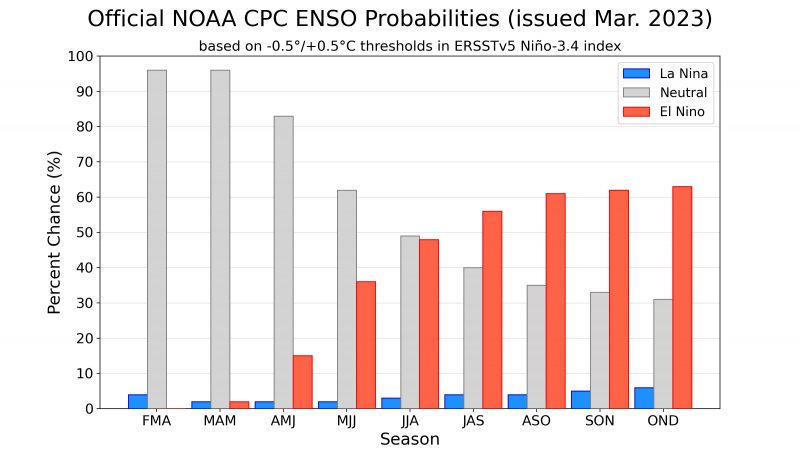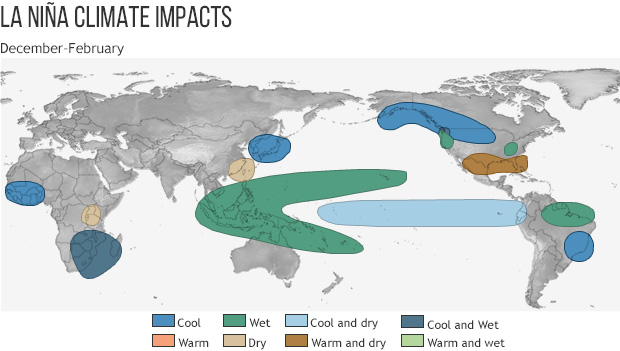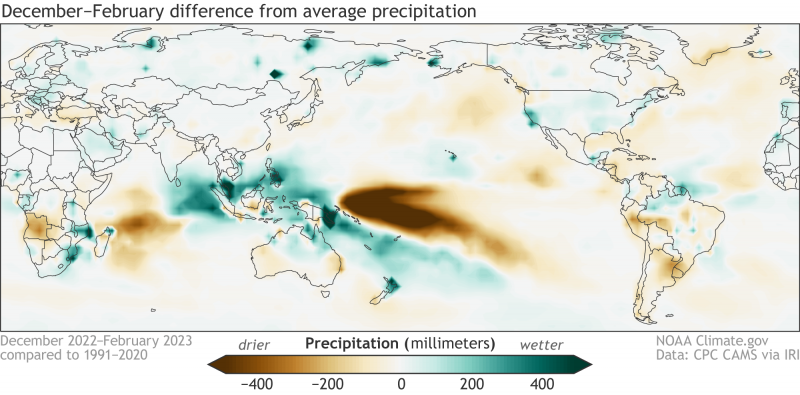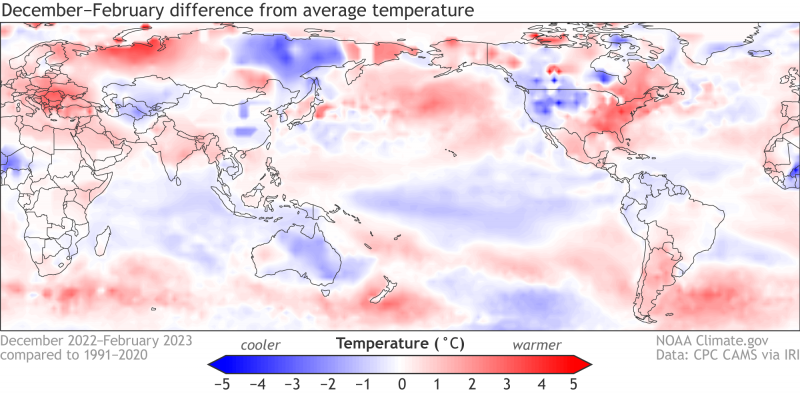
Emily Becker wrote this article, which was posted at a NOAA Climate.gov blog on March 9, 2023. Edits by EarthSky.
La Niña has left the building! It’s the cool phase of the El Niño-Southern Oscillation climate pattern (called ENSO, pronounced “en-so,” by scientists). After a year and half of non-stop La Niña, the tropical Pacific ocean-atmosphere system has transitioned to neutral. And NOAA has issued its final La Niña Advisory.
What can we expect from this climate pattern through the summer and into next fall and winter? It’s one of the most important climate phenomena on Earth, because it has the ability to change air circulation globally. So it influences temperature and precipitation across the globe.
Good-bye, La Niña
First, let’s bid La Niña adieu. The most recent weekly measurement of the sea surface temperature in the Niño-3.4 region (our primary monitoring region for La Niña and El Niño) was -0.2 C (-0.4 F), compared to the long-term average (to calculate a change in temperature in degrees Celsius to Fahrenheit, multiply by 1.8.)
Also, the latest monthly value from the OISSTv2.1 dataset was -0.4 C (-0.7 F) for this same region. The threshold for La Niña is cooler than -0.5 C.
So we can say the ocean surface has moved away from La Niña.
Last chance to get a moon phase calendar! Only a few left. On sale now.
La Niña still in the air
The atmosphere is a little more complicated, as it tends to be. We still see some indications of a La Niña-like strengthened Walker Circulation, with more rain and clouds than average over Indonesia, less over the central Pacific, and enhanced trade winds.
But, without the cooler sea-surface characteristic of La Niña, it’s likely this pattern will diminish in the coming weeks.
One measure of the atmospheric component of ENSO is the Equatorial Southern Oscillation Index (EQSOI). This measures the relationship between surface air pressure in the western and eastern Pacific. When this index is positive, it indicates that the Walker Circulation is amped up.
In February, after nearly a year at or above 1.0, the EQSOI was just 0.1. This tells us that at least one element of the atmospheric La Niña response has weakened.
What “neutral” means
We’re often going on and on here at the ENSO Blog about how ENSO is a seasonal phenomenon. This means the ocean and atmosphere criteria must be met for several consecutive months in order to qualify as La Niña or El Niño.
But the same is not true for neutral conditions. Once the tropical Pacific ocean-atmosphere system is showing signs of decoupling, such as a monthly Niño-3.4 index value warmer than -0.5 C, we can say that neutral conditions have likely arrived.
Will El Niño develop?
The forecaster consensus is indeed very confident that neutral conditions will remain through the spring. We know what you’re really interested in, though. Will an El Niño develop? If we can anticipate an El Niño, we can anticipate an increased likelihood of its impacts on weather and climate.
In contrast, a continuation of neutral conditions means the tropical Pacific Ocean will not be an actor on the world’s climate stage. The lack of El Niño or La Niña means that there is no seasonal-scale influence from the Pacific to push around the global atmospheric circulation and influence seasonal climate patterns.
Many of our computer climate models are predicting a transition into El Niño sometime later this year. But, right now is a very tricky time of year for the models, due to the spring predictability barrier. ENSO events peak in the winter and tend to decay and transition in the spring. So, models often don’t have a lot of strong signals to go on.

Possible El Niño by fall
Our forecaster consensus does reflect the increased chance of El Niño, with chances around 60% by the fall. However, the spring predictability barrier, together with the still somewhat-La Niña-ish atmosphere and the lack of strong physical signs such as a large amount of warmer-than-average subsurface water in the tropical Pacific, mean we’re not yet hoisting an El Niño Watch.
One fun little nugget of information is that, in our historical record dating back to 1950, we have not gone more than four years in a row without an El Niño. If we don’t have an El Niño in 2023–24, that will be five years!
But keep in mind that 73 years is a short record for a phenomenon that has decade-to-decade variability. So this is more of an interesting factoid than anything.
Warmth off the coast of Peru
In the sea surface temperature animation at the top of this post, you might notice a red patch growing off the coast of Peru in recent weeks. ENFEN (Peru’s commission on ENSO) recently issued a notice about the potential for a Coastal El Niño. That’s an event that can have very significant consequences for rainfall in Peru.
Coastal El Niño events can also spread west, preceding El Niño conditions in the Niño-3.4 region. So, it’s something to keep an eye on. For more on the relationship between Coastal and larger-scale El Niño, check out this conversation between Michelle and friend-of-the-Blog Ken Takahashi back in 2017 (during the last coastal El Niño event), and Ken’s post about extreme El Niño.
I reached out to Ken about current events, and he pointed out that the Madden-Julian Oscillation, an area of increased storms that travels eastward around the equator over the course of one to two months, is in a phase that directly impacts Peru. Taken with the warm ocean surface, he said this is:
… a dangerous combination that may result in even heavier rainfall than what has already started to fall onto the northern coast of Peru.
Climate prediction
As I mentioned above, the reason we care so much about El Niño and La Niña is that they can often be predicted months in advance. And that means we can get an early idea of some of our potential seasonal climate conditions. For example, the southeast coast of Africa tends to be cooler and wetter than average in December–February during La Niña.

Recent La Niña impacts
Now that this La Niña has concluded, let’s take a look – in the image below – at how the December–February rain/ snow and temperature patterns shook out around the world.

The first thing that jumps out here is the increased rain through the Maritime continent and northern Australia, and the dry region in the central Pacific, both expected La Niña impacts. Many of the more-remote impacts that are common with La Niña, including increased rainfall in southeastern Africa and northeastern South America, and drier conditions around Uruguay, are also apparent here.

La Niña is linked to some cooler-than-average global impacts, including in western Africa, eastern Brazil, and eastern Asia. We don’t expect every ENSO impact to show up every winter – with random weather variations and the influence of climate change, ENSO is hardly the only player on the field – but overall, it’s not surprising that the December–February global patterns resemble the La Niña impacts.
Bottom line: La Niña has ended and neutral conditions are now in play. Will El Niño come next, possibly by fall? Stay tuned!











